Biography
Interests
Luisetto, M.1*, Almukthar Naseer2 , Farhan Ahmad Khan3 , Mashori Gulam Rasool4 , Fiazza C.5 , Yesvi Rafa, A.6 , Ilnaf Ilman7 & Oleg Yurevich Latischev8
1IMA academy Marijnskaya Italy 29121, Professorship Pharmacology and Toxicology
2Professor, Department of Physiology/College of Medicine, University of Babylon, Iraq
3Professor, Department of Pharmacology, Jawaharlal Nehru Medical College, AMU, Aligarh
4Profesor, Department of Medical & Health Sciences for Woman, Peoples University of Medical and Health Sciences for Women, Pakistan
5Independent Researcher, Pharmacologist Italy 29121
6University of Nebraska-Lincoln, NE, USA Majoring in Biological sciences -Human Health and Disease
7Student, Dhaka Residential Model College, Dhaka, Bangladesh
8Professor, IMA ACADEMY President, Psycology, RU
*Correspondence to: Dr. Luisetto, M., IMA academy Marijnskaya Italy 29121, Professorship Pharmacology and Toxicology.
Copyright © 2022 Dr. Luisetto, M., et al. This is an open access article distributed under the Creative Commons Attribution License, which permits unrestricted use, distribution, and reproduction in any medium, provided the original work is properly cited.
Abstract
Observing REBT discipline it ispossible to verify that some irrational mental process produce Various level of behavioral problems.
Because every human cognitive task require and use a determinate quantum of “ mental-energy”Used in translating emotion in behavior.
It is interesting to focus the attention on the global management of this system. For the scope of this work MENTAL-ENERGY is not involved in any caloric value , but a quantic system of level of mental effort for various cognitive or emotional task.
Related the literature analysed it is clear that all unfunctional mental process ( mindset kinetics) Produce and umbalance in long term with relevant behavior implication in variuos settings ( socila, individual, working, family). In this work the topic is analized using a multidisciplinar poin of view, psycological, neuroscience, management and other useful.
Introduction
This work aim to analize the preblem related the mind energy kinetics and its malfuntions due by some condition.
For this scope the term mind energy has not a connotation of caloric measure but a measure of mental effort that the various midn activity is required an used.
An overload of mental work or abnormal irrational thinking process related emotional translation can produce unbalance in this complex system.
External stimuli , emotions registered and elaborated by brain- mind complex cna results in an inefficient behavior for today society.
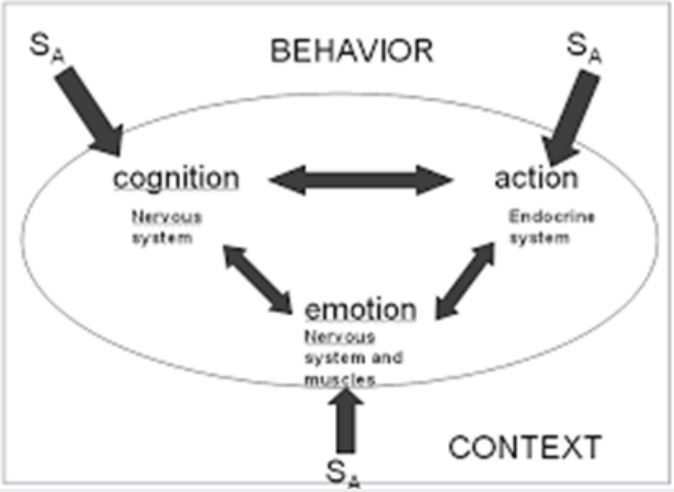
Emotion and Rationality: A Critical Review and Interpretation of Empirical Evidence
Michel Tuan Pham June 1, 2007 Research Article
https://doi.org/10.1037/1089-2680.11.2.155
“The relation between emotion and rationality is assessed by reviewing empirical findings from multiple disciplines. 2 types of emotional phenomena are examined - incidental emotional states and integral emotional responses - and 3 conceptions of rationality are considered - logical, material, and ecological. Emotional states influence reasoning processes, are often misattributed to focal objects, distort beliefs in an assimilative fashion, disrupt self-control when intensely negative, but do not necessarily increase risk-taking. Integral emotional- responses are often used as proxies for values, and valuations based on these responses exhibit distinct properties: efficiency, consistency, polarization, myopia, scale- insensitivity, reference-dependence. Emotions seem to promote social and moral behavior”.
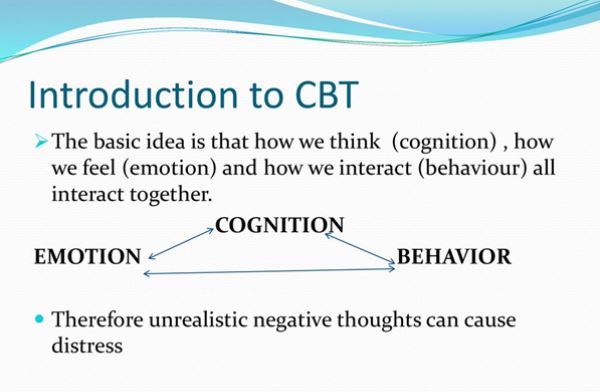
Hum Brain Mapp. 2022 Feb 15; 43(3): 1011-1031.2021 Nov 5. doi: 10.1002/hbm.25703
Facing successfully high mental workload and stressors: An fMRI study
Mickaël Causse, Evelyne Lepron, Kevin Mandrick, Vsevolod Peysakhovich, Isabelle Berry, Daniel Callan, and Florence Rémy
“A fine‐grained understanding of how the brain copes with an important mental- workload or a stressful situation is a major issue to promote human performance in a challenging environment. Complex and safety‐critical activities, such as piloting an airplane or operating a nuclear power- plant, can lead to a drastic and simultaneous increase of both mental work-load and acute- stress”.
OPINION article
Front. Psychol., 16 February 2022 | https://doi.org/10.3389/fpsyg.2022.74255
Emotion Regulation, Effort and Fatigue: Complex Issues Worth Investigating
Karol Lewczuk, Magdalena Wizła, Tomasz Oleksy and Mirosław Wyczesany
“Emotion regulation refers to the processes by which individuals can influence the type of emotions they have, for how long as well as how strongly they experience and express them. ER is not simply constrained to diminishing negative emotions, but can include up- as well as down- regulation of both positive and negative emotional states, depending on one’s regulatory aims. ER can happen both on an individual level, as well as in a group context, and on a conscious and deliberate, as well as an automatic level. ER requires significant effort to be exerted, which can affect its efficiency. This is especially the case for explicit and intentional ER of one’s emotion as automatic and implicit ER can potentially be applied with no significant effort. Investigating if and how ER- effectiveness can diminish as a result of investing effort and the resulting fatigue is crucially important, as in daily life people are often put in circumstances that routinely require prolonged, incessant or recurring engagement in ER during work , education , self-regulated learning , social interactions”
Ind Psychiatry J. 2010 Jan-Jun; 19(1): 37–40.
doi: 10.4103/0972-6748.77634
Development of emotional stability scale
M. Chaturvedi and R. Chander
“Thorndike and Hagen consider that emotional -stability of a person is characterized by evenness of moods, intent, interests, optimism, cheerfulness, composure, feeling of being in good health, freedom from feeling of guilt, worry or loneliness, freedom from day dreaming, freedom from perseveration of ideas and moods.
Smithson has viewed emotional stability as a multi-trait non-cognitive psychological concept. He defines emotional -stability as ‘a process in which personality is continuously striving for greater sense of emotional health both intra-psychically and intra-personality. Emotional stability enables the person to develop an integrated and balanced way of perceiving the life problems. This organizational ability and structured perception helps one to develop reality-oriented thinking, judgment and evaluation ability. One develops feelings, perceptions and attitudes that help in understanding the realities of life and conditions and circumstances that create miserable situations in life. Such kind of understanding helps one promote high ego strength.
The study was conducted in 3 phases. Based on the concept of emotional- stability as defined in the literature, 250 items were developed covering initially the following 6 dimensions of emotional stability:
The items were given to the judges, who were qualified psychologists with minimum ten years of experience in the field of personality assessment. Out of these, 90 items were such where the judges could not reach a consensus, these items were eliminated and only 160 items were retained for the initial trial. Besides this, the judges felt that there was an over-lapping of items in the last 2 subscales i.e. emotions vs. logic and apathy vs. empathy. Hence the items of these subscales were merged together and the scale had only 5 dimensions.
Pessimists are gloomy and depressed, disappointed with their existence and at odds with the world. They
have low self-esteem level, are introverts, have feelings of guilt, interpersonal dependency, and remain passive
in the social situations.
Optimists are generally cheerful and positive in their outlook. They are satisfied with themselves, find life rewarding, and are at peace with the world. They show persistence in seeking goals in spite of set-backs and obstacles, operating from the hope of success rather than fear of failure. They perceive failures as being due to manageable circumstances rather than a personal flaw.
In Example: Do you seem to have more than your share of bad luck?
People who are apathetic are detached, shrewd, worldly and expedient and harbor self- interest in their
dealings with the other people.
Empathy is an ability to feel for other people. People who are empathic in nature consider other’s feelings along with related factors in the process of making intelligent decisions. They are warm hearted, trusting, straight forward and altruistic.
In Example: Does it worry you if someone is annoyed with you for a mistake, which you have actually not committed?
The dependent person lacks self-reliance, thinks of himself as a helpless pawn of fate, is pushed around by
other people and events and shows a high degree of authoritarian submission (the unquestioning obedience
to institutional power).
The persons high on autonomy enjoy a great deal of freedom and independence, make their own decisions, view themselves as a master of their own fate and take realistic- actions to solve their own problems.
In Example: Do you place your trust in supernatural powers such as God or fate to see you through safely?
Anxious persons are easily upset by things that go wrong and are inclined to worry un-reasonably about
things that may or may not happen. Such kind of people account for a high consumption of liquor or other
narcotic agents.
People who are calm are placid, serene and resistant to irrational fears and anxieties. Because of this ability they can stay calm under pressure. They can also think clearly and stay focused.
In Example: Do you often feel restless as though you want something but do not really know what?
Aggressive individuals are given to the direct or indirect expression of anger, behavior such as temper tantrums,
fighting, violent arguments and sarcasm, or participation in adventurous activities like mountaineering, car
rallies etc. They take no non-sense from anyone and feel compelled to return fire or get back at anyone who
transgresses against them.
Tolerant individuals are gentle, even tempered, with no personal conflicts and are not given to violence either direct or indirect. They efficiently manage their disruptive emotions and impulses.
Construct validity of the scale was measured in terms of inter-correlation between subscales of Emotional Stability -Scale and total scale. Correlation- matrix reveals that the inter-correlation among various subscales ranged from .135 between aggression vs. tolerance and apathy vs. empathy to .503 between dependence vs. autonomy and pessimism vs. optimism. All the correlations were found to be significant at P<.01 and above. All the sub-scales showed significantly positive correlation with the total score on the test ranging from .33 (aggression vs. tolerance) to .63 (anxiety vs. calm).”
REVIEW article
Front. Neurosci., 07 April 2020 | https://doi.org/10.3389/fnins.2020.00268
A Neuroergonomics Approach to Mental Workload, Engagement and Human Performance
Frédéric Dehais, Alex Lafont, Raphaëlle Roy and Stephen Fairclough
“Mental Workload Measurement Scientific Research into the measurement of mental workload has outstripped the development of theoretical frameworks. Measures of mental work-load can be categorized as performance-based, or linked to the process of subjective self-assessment, or associated with psychophysiology or neuro-physiology.”
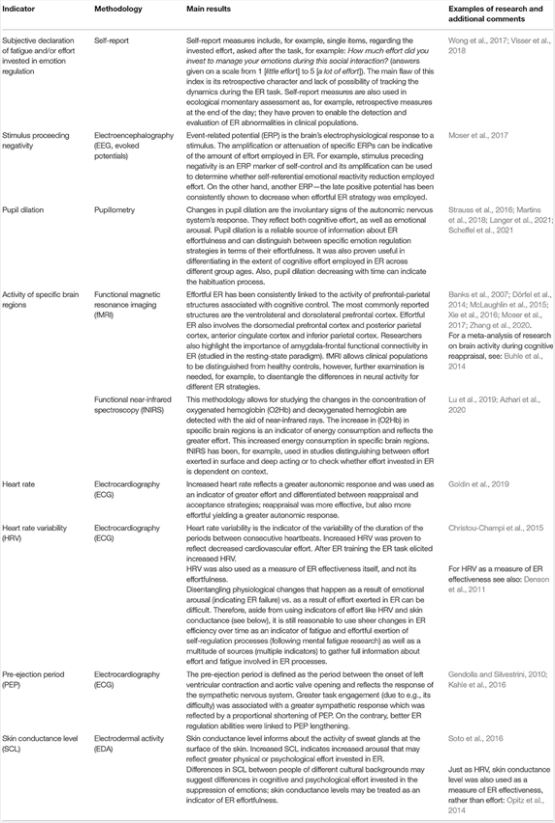
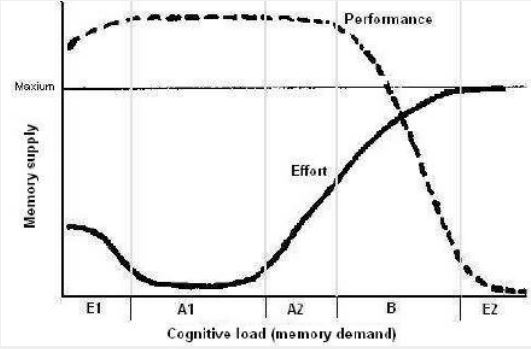
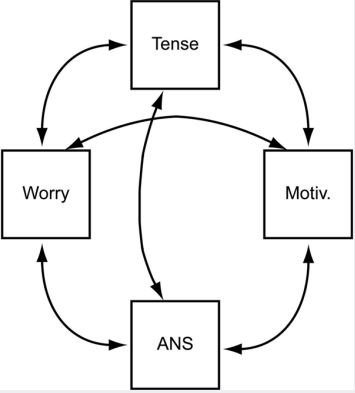
Front. Psychol., 30 April 2020 | https://doi.org/10.3389/fpsyg.2020.00742
All Happy Emotions Are Alike but Every Unhappy Emotion Is Unhappy in Its Own Way: A Network Perspective to Academic Emotions
Markus Mattsson, Telle Hailikari and Anna Parpala
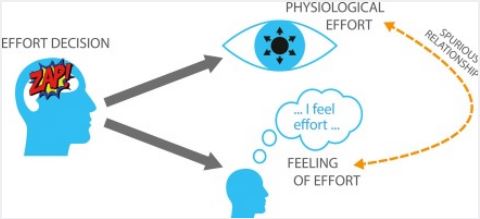
Fig. n 4 from Consciousness and Cognition
Volume 63, August 2018, Pages 218-227
Consciousness and Cognition
The feeling of effort during mental activity
Author links open overlay panelErikBijleveld
https://doi.org/10.1016/j.concog.2018.05.013
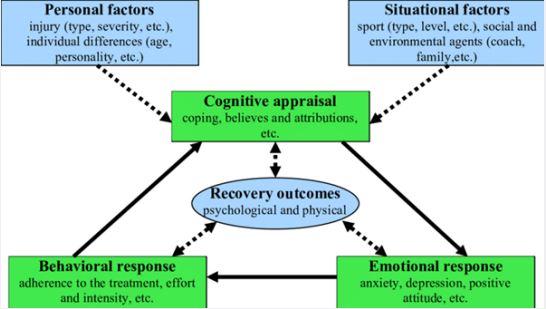
Fig. n 5 from DOI: 10.4100/jhse.2013.84.13
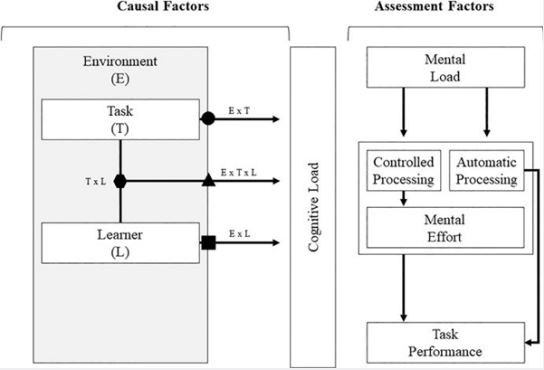
Fig. n 6 from https://doi.org/10.3389/feduc.2021.632907
FromChristian Korunka, Sara Tement (University of Vienna)
Cristina Zdrehus, Adriana Borza (University of Oradea)
“The “burn-out” metaphor example implies not only that somebody had to be “burning” ( is strongly liked
his/her job, was strongly committed) before he or she would be able to “burn-out”, but also that once a fire is
burning, it can not continue to burn unless resources are provided to keep it on burning. Employees’ energy
or capacity to work can diminish over time when the work environment does not provide resources and is
especially demanding. In a terminal stage a state of physical, emotional and mental exhaustion will occur
from which it is hard to recover. There is another metaphorical meaning of burnout: Somebody could only
burn out if he or she was “burning” before. Thus, engagement, enthusiasm and interest in someone’s job are
a necessary precursor of burn-out.”
Material and Methods
Whit an observational point of view some relevant literature is analyszed and an experimental hypotesys is submitted in order to produce a global conclusion.
Figures reported help to show the concept involved.
All literature comes frome biomedical databases
Results
From literature:
Varius Emotional Task Require Different Energy Consuption
Review Nutr Neurosci. Oct-Dec 2007; doi: 10.1080/10284150701722273.
Cognitive methods for assessing mental-energy
Harris R Lieberman
DOI: 10.1080/10284150701722273
“Mental-energy is not well defined but of considerable public interest. Although the physical- energy required to complete a task can be objectively specified, the concept of mental-energy is relatively new. Mental-energy is a mood, but can also be defined as ability or willingness to engage in the cognitive work. This review work addresses the concept of mental-energy and cognitive tests used to assess it. Methods that can be used to assess mental-energy, including tests of cognitive performance, mood questionnaires, electro-physiological techniques, brain scanning -technologies, and ambulatory monitoring, are discussed. Studies of the factors affecting mental- energy, such as drugs, foods, sleep deprivation, and disease states, are also reviewed. In global aggregate, the studies reviewed suggest use of cognitive tests that assess vigilance, ability to sustain attention, and choice reaction time are optimal for assessment of mental-energy. Specific tests recommended include the psycho-motor vigilance task, Wilkinson 4-choice visual reaction time, the scanning visual vigilance test, and Wilkinson auditory vigilance test. These tests are sensitive to factors that both increase and decrease mental-energy.” [1].
Front Neurosci . 2019 Dec 5;13:1292. doi: 10.3389/fnins.2019.01292. eCollection 2019.
Mental Effort and Information-Processing Costs Are Inversely Related to Global Brain Free Energy During Visual Categorization
Logan T Trujillo
DOI: 10.3389/fnins.2019.01292
“Mental effort is a neuro-cognitive process that reflects the controlled expenditure of psychological information-processing resources during perception, cognition, action. There is a practical need to operationalize and measure mental effort in order to minimize detrimental effects of mental fatigue on real-world human performance. Previous scientific research has identified several neuro-cognitive indices of mental effort, but these indices are indirect measures that are also sensitive to experimental demands or general factors such as sympathetic arousal.
The present study work investigated a potential direct neuro-cognitive index of mental effort based in theories where bounded rational decision makers (realized as embodied brains) are modeled as generalized thermo-dynamic systems. This index is called free- energy, an information-theoretic system property of the brain that reflects the difference between the brain’s current and predicted states. Theory predicts that task related differences in a decision makers’ free energy are inversely related to information-processing costs related to task- decisions. The present study tested this prediction by quantifying global brain free energy from EEG measures of human brain function. EEG signals were recorded while participants engaged in 2 visual categorization tasks in which categorization decisions resulted from the allocation of different levels of mental information processing resources. A novel method was developed to quantify brain free energy from machine learning classification of EEG trials. Participant information-processing resource costs were estimated via computational analysis of behavior, whereas the subjective expression of mental effort was estimated via participant ratings of mental work-load. Following theoretical predictions, task related differences in brain free energy negatively correlated with increased allocation of information processing resource costs. These brain free energy differences were smaller for the visual categorization task that required a greater versus lesser allocation of information-processing resources. Ratings of mental work-load were positively correlated with information-processing resource costs, and negatively correlated with global brain free -energy differences, only for the categorization task requiring the larger amount of information-processing resource costs. These findings support theoretical thermo-dynamic approaches to decision making and provide the first empirical evidence of a relationship between mental -effort, brain free energy, and neuro-cognitive information-processing. The present study investigated a system property of the brain called free energy that in theory is directly sensitive to the information-processing resource costs allocated through mental -effort. The concept of free energy originated in thermodynamic physics where it is a measure of the work (or useful energy) a physical system can exert after accounting for internal energy -losses due to heat. Brain free energy is an information-theoretic generalization of this concept that reflects the brain’s surprise – the difference between the brain’s current and predicted states. In this kind of context, free energy acts as a motivating influence for the brain in that the latter seeks to minimize its free energy (and thus its surprise) in order to maintain physiological homeostasis. The minimization of the brain’s free energy corresponds to a process of approximate Bayesian inference that has important consequences for perception, cognition, and action. The process of brain free -energy minimization has been termed the FEP” [2].
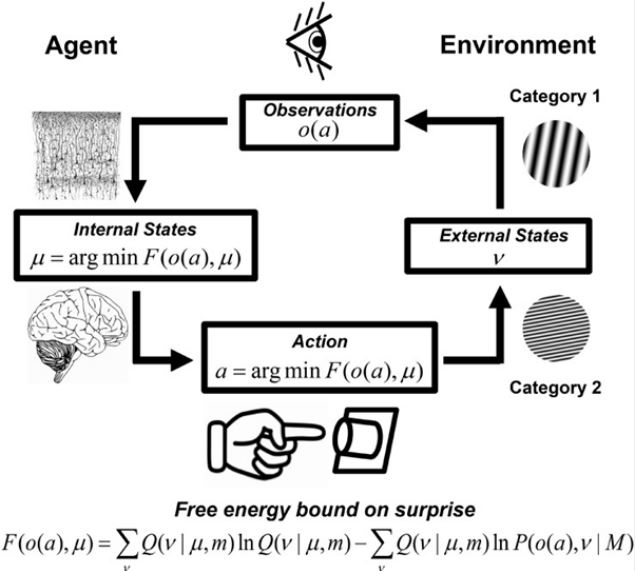
FIG. n 7 Approximate Bayesian-inference and free energy minimization in visual categorization. External world states ν encompass hidden causes of observations o. Observations may also be influenced by actions a, which change external world states and resultant observations. Brain free -energy and surprise is minimized when (1) the brain, parameterized by internal neural states μ, approximately predicts the causes of observations according to model m that partially-encodes an optimal model of the world M, or (2) when the brain’s actions change external world states and resultant observations to be in accordance with predictions based on a sub-optimal world model m encoded by the brain. from Comparative Study of the Sensory Areas of the Human Cortex by S. Ramón y Cajal, 1899, Worcester, MA, United States: Clark University (Ramón y Cajal, 1899. FROM Logan T. Trujillo
Front Psychol. 2021 Aug 20;12:717414. doi: 10.3389/fpsyg.2021.717414. eCollection 2021.
Deriving Mental-energy From Task Completion
Xiang Wang , Chris Janiszewski , Yanmei Zheng , Juliano Laran , Wonseok Eric Jang
DOI: 10.3389/fpsyg.2021.717414
“Many tasks in every-day life (making an accurate decision, completing job tasks, and searching for product information) are extrinsically motivated (the task is performed to gain a benefit) and require mental effort. Prior research shows that the cognitive resources needed to perform an extrinsically motivated task are allocated pre-task. The pre-task allocation of mental resources tends to be conservative, because mental effort is costly. Consequently, there are mental-energy deficits when the use of mental -resources exceeds the allocated amount. This research provides evidence for post-task mental-energy replenishment. The amount of resource -replenishment is a function of the size of the mental- energy deficit and the favorability of the cost-benefit trade-off experienced at the completion of the task ( the value of the reward given the energy investment). The findings have implications for how cognitive resources- management influences the availability of mental-energy on a moment-to-moment basis” [3].
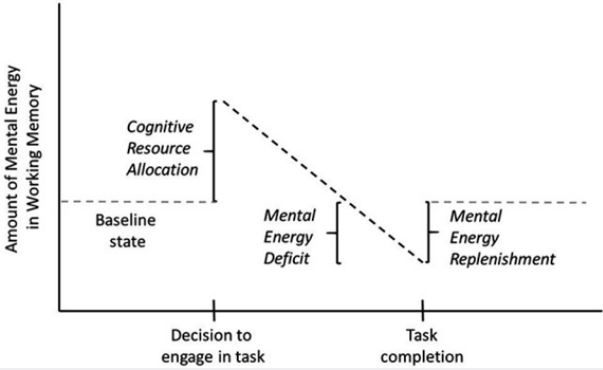
From n. 8 Illustration of cognitive resource allocation, a mental-energy deficit, and replenishment. The baseline level of mental-energy is shown by the gray dashed line. The decision to engage in a task increases the level of mental-energy (cognitive resource -allocation). The amount of mental- energy used during the completion of a task can be more than was allocated (mental-energy deficit). Task completion provides an opportunity for mental-energy replenishment. From Xiang Wang et al
Edwards, Elizabeth J. Edwards, Mark S. Lyvers, Michael
(2015). Cognitive trait anxiety, situational stress, and mental effort predict shifting efficiency: Implications for attentional control theory. Emotion, 15(3), 350–359.
https://doi.org/10.1037/emo0000051
“Attentional control theory predicts that trait anxiety and situational stress interact to impair performance on tasks that involve attentional shifting. The theory suggests that anxious individuals recruit additional effort to prevent shortfalls in performance effectiveness (accuracy), with deficits becoming evident in processing efficiency (the relationship between accuracy and time taken to perform the task). These assumptions have not been systematically tested. The relationship between cognitive trait anxiety, situational stress, and mental effort in a shifting task (Wisconsin -Card Sorting Task) was investigated in 90 participants. Cognitive trait- anxiety was operationalized using questionnaire- scores, situational stress was manipulated through ego threat instructions, and mental effort was measured using a visual analogue scale. Dependent variables were performance effectiveness (an inverse proportion of perseverative errors) and processing efficiency (an inverse proportion of perseverative -errors divided by response time on perseverative error trials). The predictors were not associated with performance effectiveness; we observed a significant 3-way interaction on processing efficiency. At higher mental effort (+1 SD), higher cognitive trait anxiety was associated with poorer efficiency independently of the situational stress, whereas at lower effort (–1 SD), this relationship was highly significant and most pronounced for those in the high-stress condition. These results are important because they provide the first systematic test of the relationship between trait- anxiety, situational stress, and mental effort on shifting performance. The data are also consistent with the notion that effort moderates the relationship between anxiety and shifting efficiency, but not effectiveness“ [4].
Ergonomics. 1993 Sep;doi: 10.1080/00140139308967972.
Comparing the concepts of mental load and stress
DOI: 10.1080/00140139308967972
“This paper work delineates mental load and stress as 2 related concepts that originate from different theoretical frameworks. A proper distinction between the 2 concepts is important, not only for theory building, but because it may lead also to different interpretations of experimental results, and, consequently, to different recommendations in applied situations. High work-load is regarded as an important but not a critical factor in the development of stress -symptoms. It is quite possible to work hard in difficult and complex tasks, even under un-favourable conditions, without cognitive strain, psychosomatic complaints, or adverse physiological effects. High task demands can be met by mobilizing extra energy through mental effort. This ‘trying harder’ reaction is a normal and healthy coping strategy to adapt to situational demands. In contrast, stress is regarded as a state in which the equilibrium between cognitive and energetical -processes is disturbed by ineffective energy mobilization and negative- emotions. Stress typically is characterized by inefficient behaviour, over-reactivity, and the incapacity to recover from work. Stress is regarded as a state in which the physiological system is disorganized, which results in decreased well-being, sleeping problems, psycho-somatic complaints, and increased health risks” [5].
Emotions correlate with perceived mental effort and concentration disruption in adult sport performers
Mark S. Allen,Marc Jones,Paul J. McCarthy,Sam Sheehan-Mansfield & David Sheffield
20 Feb 2013
https://doi.org/10.1080/17461391.2013.771381
“2 studies explored the relationship between emotions, perceived mental effort and concentration disruption in adult sport performers. In Study A, semi-professional association football players completed questionnaire measures before and after a competitive match. In Study B, student athletes completed questionnaire measures for 2 performance scenarios: one in which they were performing above their normal level and one in which they were performing below their normal level. Findings demonstrated that cognitive trait anxiety was associated with greater disruptions in concentration but was un-related to mental effort. For state measures, athletes reported greater levels of concentration disruption when experiencing high levels of anxiety or high levels of happiness, and fewer disruptions in concentration when experiencing high levels of excitement. Findings also showed that excitement was associated with low levels of mental effort during good performances and high levels of mental effort during poor performances; anxiety and happiness were associated with high levels of mental -effort during good performances and low levels of mental effort during poor performances. Taken together, these studies works point towards potential benefits accompanying high levels of excitement and potential dis-advantages accompanying high levels of anxiety and happiness” [6].
ORIGINAL RESEARCH article
Front. Educ., 12 April 2021 | https://doi.org/10.3389/feduc.2021.632907
Analyzing Relationships Between Causal and Assessment Factors of Cognitive Load: Associations Between Objective and Subjective Measures of Cognitive Load, Stress, Interest, and Self-Concept
Nina Minkley,Kate M. Xu and Moritz Krell
“Emotion (Stress)
Emotions, in particular negative valence emotions, have been suggested to be a source of increased extraneous load” [7].
Research Articles, Behavioral/Cognitive
Reason’s Enemy Is Not Emotion: Engagement of Cognitive Control Networks Explains Biases in Gain/ Loss Framing
Rosa Li, David V. Smith, John A. Clithero, Vinod Venkatraman, R. McKell Carter and Scott A. Huettel
Journal of Neuroscience 29 March 2017, DOI: https://doi.org/10.1523/JNEUROSCI.3486-16.2017
“In the classic gain/loss framing effect, describing a gamble as a potential gain or loss biases people to make risk-averse or risk-seeking decisions, respectively. The canonical explanation for this effect is that frames differentially modulate emotional -processes, which in turn leads to irrational choice behavior.We evaluate the source of framing biases by integrating functional magnetic resonance imaging data from 143 human participants performing a gain/loss framing task with meta-analytic data from >8000 neuro-imaging studies. We found that activation during choices consistent with the framing- effect were most correlated with activation associated with the resting or default brain, while activation during choices inconsistent with the framing effect was most correlated with the task-engaged brain. Our findings argue against the common interpretation of gain/loss framing as a competition between the emotion and control. Instead, our study work indicates that this effect results from differential cognitive- engagement across decision frames.
SIGNIFICANCE STATEMENT The biases frequently exhibited by human decision makers have often been attributed to the presence of emotion. Using a large fMRI -sample and analysis of whole-brain networks defined with the meta-analytic tool Neuro-synth, we find that neural activity during frame-biased decisions was more significantly associated with default behaviors (and the absence of executive control) than with emotion. These findings point to a role for neuro-science in shaping long-standing psychological theories in decision science.
Our study work , using a large fMRI dataset and an even larger meta-analytic database, suggests that “less cognitive effort” versus “more cognitive effort” is the more accurate characterization of decision-making processes” [8].
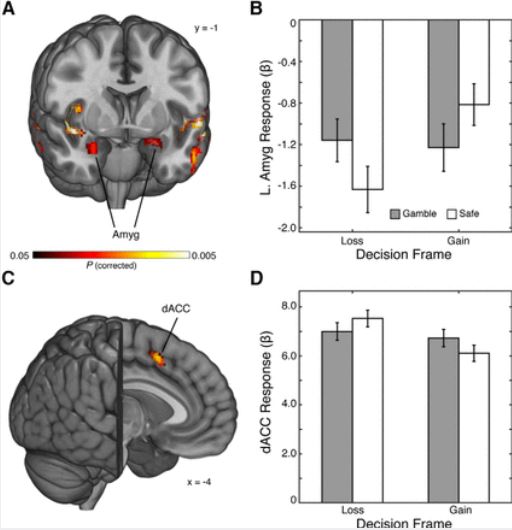
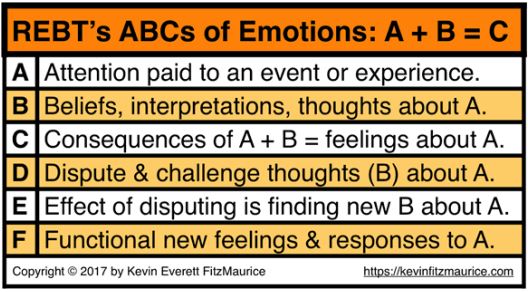
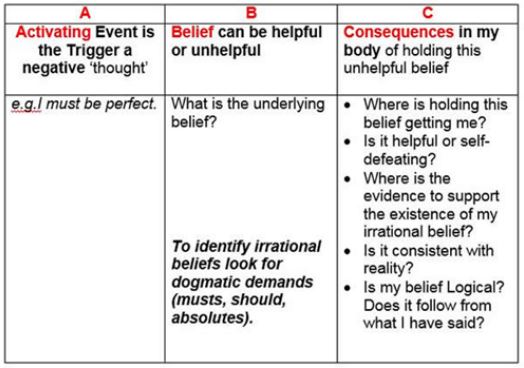
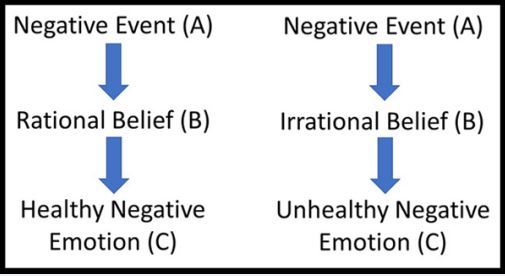
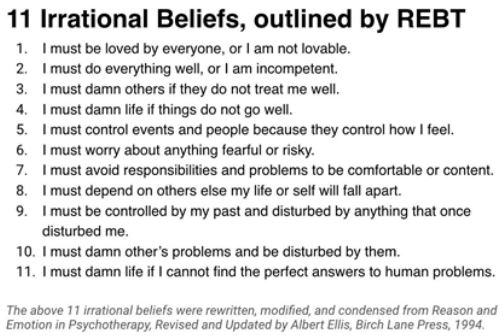
Clinical Psychology & Psychotherapy
RESEARCH ARTICLE
Pathways into psychopathology: Modeling the effects of trait emotional intelligence, mindfulness, and irrational beliefs in a clinical sample
K. V. Petrides,María G. Gómez,Juan-Carlos Pérez-González
21 February 2017 https://doi.org/10.1002/cpp.2079
“Our emotional- perceptions, reasoning processes, and ability to maintain awareness on a moment‐to‐ moment basis play an important role in the development and maintenance of mental -illness. Up to about half the variance in total MCMI scores can be accounted for by individual differences in trait EI, mindfulness, and irrational beliefs.
The structural equation and hierarchical -regression models suggest that negative emotional self‐perceptions are perhaps more fundamental than irrational thinking or lack of awareness in the development of psychopathology. It seems that such self‐perceptions lead to psycho-pathology both directly, but also indirectly, through clouding awareness and fueling irrational thinking. A series of hierarchical regressions demonstrated that trait EI is a stronger predictor of psycho-pathology than mindfulness and irrational beliefs combined. We conclude that the identified path-ways can provide the basis for the development of safe and effective responses to the ongoing mental health and over-medication crises” [9].
(Toward a Rational and Mechanistic Account of Mental Effort. Available from: https://www.researchgate. net/publication/311825391_Toward_a_Rational_and_Mechanistic_Account_of_Mental_Effort.
“Given this seemingly immediate availability to introspection,mental effort is surprisingly difficult to Pin down as an object of scientific studyes.
What exactly is the mental effort, from an objective rather than introspective point of view?
What exactly is going on when we try harder on a cognitive task or decide that this trying is not worth it?
What is being conserved when we conserve our cognitive- resources, and how do we decide the manner in which those resources get allocated?
And how can we identify the neural- mechanisms under-lying such a subjective construct?
Our aim in the present article is to review some areas of recent progress in addressing these questions” [10].
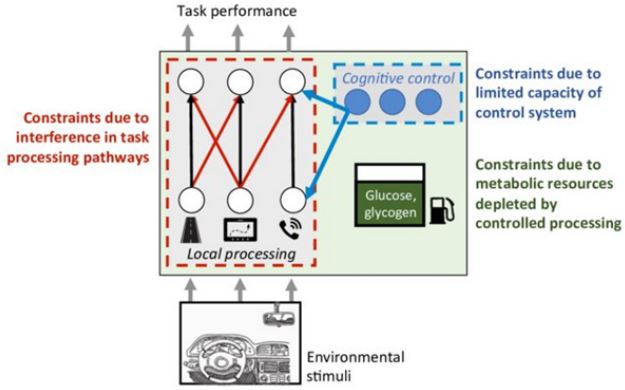
Published: 12 July 2007
Irrational Beliefs and Unconditional Self-Acceptance. III. The Relative Importance of Different Types of Irrational Belief
Martin F. Davies
Journal of Rational-Emotive & Cognitive-Behavior Therapy volume 26, pages102–118 (2008)Cite this article
“In 2 studies, one correlational (N = 158) and one experimental (N = 128), using college students, it was found that Need for Achievement, Need for Approval and Self-Downing were the most important irrational -beliefs of the General Attitude and Belief Scale predicting unconditional self-acceptance. The Need for Comfort, Demand for Fairness and Other-Downing sub-scales were found to be less influential. The findings were discussed in terms of Ellis’ theoretical formulation of four higher-order types of irrational belief processes (demandingness, awfulizing, low-frustration tolerance and self-downing), empirical research on different irrational- belief themes, the distinction between ego -disturbance and discomfort disturbance in REBT and the distinction between sociotropy and autonomy in different forms of depression” [11].
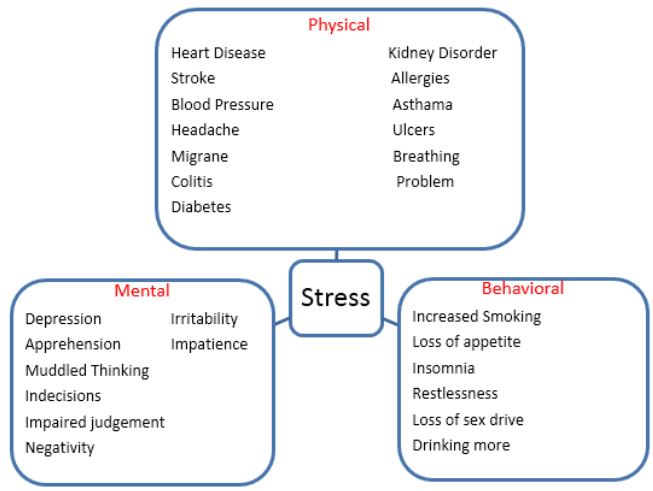
Fig. n from M. Thakur
From from M. Thakur
“Some useful stress management techniques include:
Time -Management: Time limitations can elicit stress in people’s lives. Work schedules sometimes become over-loaded, which causes some individuals to feel overwhelmed. In order to manage this kind of situation, one can make a plan of priorities to do the work accordingly. This will help to reduce the stress and even a manageable schedule which can complete within the time- frame.
Self-limitations: Knowing your own limitation and performing your work accordingly helps to alleviate the un-necessary stress. Creating your own boundaries is essential for healthy, stress-free living. Boundaries mean we create some internal rules for our-selves to take care of our well-being. Sometimes it is good not to involve in any kind of racing thoughts which may also aggravate stress. It is suggestible to deviate your mind from that kind of thought and involve yourself with some activities which give relaxation and refreshment to your mind.
Friendly social network: Sometimes, a supportive network of friends and relatives help to face the challenging situation with stability and less stress. Their encouraging -words and listening ears become supportive.
Reduce the noise: You may try to distract yourself from all kinds of technologically advanced gadget and manage some time to stay in quiet. You can notice that those things which you consider most important for day to day life are very trivial.
ABC technique: The well-known ABC (A – Adversity or stressful situation, B – Beliefs or the way response to the situation, C – Consequences or the result of your belief ) technique was first introduced by psychiatrist DR. A.Ellis, and later it was adopted by M. Seligman. The purpose of the technique is to think optimistically.
Healthy Diet: A healthy balanced diet gives fuel to the body and mind function; it helps us to cope up with any stressful- situation. Reducing the consumption of alcohol, caffeine, sugar is a proven way of decreasing stress or anxiety. If our body gets proper nutrients, stress can likely occur in our every-day life.
Exercise: Maintaining a consistent routine exercise is a sign of following a healthy lifestyle. The Exercise helps our body to reduce tensions and relax the muscles.
Meditation: Use the techniques of deep breathing, breathing exercise, yoga, yogic sleep, meditation to control our physical and mental -being. Meditation helps to calm down our body and mind to awaken our inner power.
Sleep habit: Adequate sleep is necessary to rejuvenate ourselves. It is helpful to boost our immune- power and also increases mental alertness, memory, and the concentration.
Actually, stress comes about because our mind is every-where, either regretting the past or glorifying the future. That is why we should develop certain stress -management skill to cope up with stress in our daily activities and be able to adore healthy- life.”
Towards a new paradigm in the psycho-therapy process research: An empirical study on text analysis and
Psycho-physiology
Kleinbub Johann Roland,, Gennaro Alessandro, Palmieri Arianna,Benelli Enrico, Salvatore Sergio
“Recent theoretical and empirical advancements in scientific literature are leading toward a paradigm shift in the research of psycho-therapy process, in terms of: a) a focus on moment-by-moment inter-personal or inter-subjective exchanges, b) the study of their temporal- dynamics, c) the preference for idiographic and explorative designs and d) the use of objective measurement- tools such as physiological measures, and computer-assisted analysis of videos and transcripts of the clinical -interactions.
In regard to the latter, the use of Interpersonal Physiology as a tool to investigate the somatic perspective in the clinical setting is receiving increasing interest. IP consists in the analysis of the simultaneous physiological activity in 2 interacting persons and is being increasingly investigated as a biomarker of inter-personal emotional regulation.
In psycho-therapy research, the technique has been successfully used to associate the synchronization of skin conductance (SC) to various interpersonal constructs, such as empathy and therapeutic alliance. While IP techniques have already been employed to investigate the interaction dynamics of a therapist-patient dyad , to the best of our scientific- knowledge no research effort in literature has yet empirically studied the convergence between clinical micro-process and IP” [12].
ORIGINAL RESEARCH article
Front. Psychol., 29 March 2018 | https://doi.org/10.3389/fpsyg.2018.00427
Assessment of Affect Lability: Psychometric Properties of the ALS-18
Anna Contardi, Claudio Imperatori, Italia Amati, Michela Balsamo and Marco Innamorati
“To measure affect -lability, Harvey et al. (1989) developed the Affective Lability Scales (ALS), a 58- item questionnaire measuring changeability among euthymia and four affect states (depression, elation, anger, anxiety). The construct of affect lability has strong- relationships with other personological constructs such as neuroticism and cyclothymia. Neuroticism (also known as emotional stability-instability or negative emotionality) is part of major models of normal personality structure (Eysenck’s 3 Factor model, and the Big 5 model) and it is an ubiquitous element of many personality measures. Negative emotionality is a central component in neuroticism, along with cognitive and behavioral- facets Questionnaires assessing neuroticism generally measure the frequency of negative emotional- states and how easily they are experienced by the individual” [13].
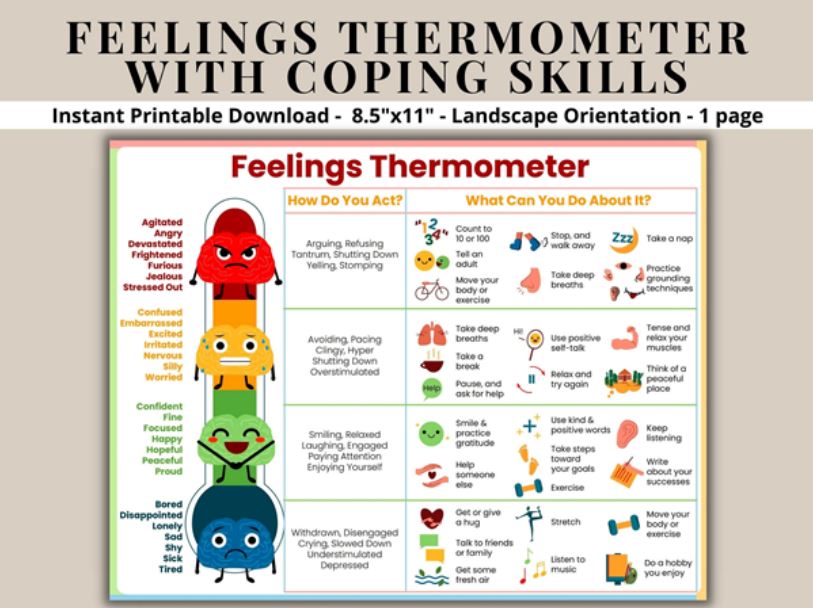
Fig. n 15 from https://mentalhealthcenterkids.com/products/feelings-thermometer-with-coping-skills-emotions-chart-poster-kids-teens
In order to verify the entity in “mentale energy” use it is possible to think to an experimetal project
Involving 20 individuals.
They must to be divided in 2 groups : control A and interventistic B
Intervention: simply to give them the order to delay solution of problem during great emotional task
After a time like 24-48 horus.
Control : not applicable this upper rule
Blind : the member of this 2 groups A and B must to be not informed related this rules
Collecting the results: all episode must to be subjectually evalued on a scale from 1 to 10 related intensity of emotional disconform.
Results : all resulta must to be collected and recorded in a documenta file for the statistical analisys
Significativity : > 0,05
RESULTS INTERPRETATION: if in this esperimental hypotesys i twill be find a significative variation between control and intervention group it can be assumed that the delay order is effective to reduce this kind of stressor agent and that this expedient can be submitted to researcher to provide instrument for a behavioral improvement of the subject inetrested.
Discussion
REBTS is an interesting instrumet that show as some irrational mental process can produce Behavioral mulfunction.
Ruminate on problems, tunnel thinking, cathastrofic idea, low level of autostima and other similar Mechanims can use too much quantum of “mental-energy “ and this can produce in long time
Various level of behavioral social disfunctions.
Conclusion
It is possible to consider that related various mental process (irrational) and expecially in subject with
mulfunction of the emotional sfera there is a relevant use of a so called “mental-energy”.
A chronic permanence of this condition can evolve in great disconfort , stress, born out or depression status or anxia (in social enviroment, work, family).
In order to improve this vicious cycle it is fundamental to deeply study the mindset kinetics and the mental efforst needed in the various mental process ( rational or irrational) as well as to verify the contribute played in this process by reptilian brain , mammalian brain and by the cortex.
If in an primitive world ( archeo) the reaction of attack and escape was a safe life mechanism for many animals ( also humans ) today this mechanism if not adeguately controlled can create varioous problems in today social situations.
A quantitative methods is needed to give a numeric value to all this process.
Brain and mind show a determinate and limitated level of mental-energy so it is needed to use better it is possibile this extra ordinary instrument.
Conflict of Interest: No
Etical Consideration: Every international rule is applied
Bibliography

Hi!
We're here to answer your questions!
Send us a message via Whatsapp, and we'll reply the moment we're available!